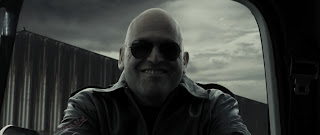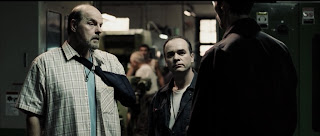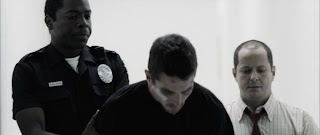This is the thriller film idea mind map I have completed, this shows various important aspects of my thriller film idea.
Tuesday, 30 October 2012
Pscychological Thriller Collage
This is my psychological thriller collage in which I compiled from various films. This is what I have in mind regarding the type of thriller film I am going to produce and how it will look. I am interested in showing the unstable state of mind of a character along with the psychological conflict characters encounter. The three films that have influenced my choice are:
The Sixth Sense
The Machinist
Shutter Island
The Sixth Sense
The Machinist
Shutter Island
Sunday, 28 October 2012
Spoiler Review - The Machinist
 The film The Machinist is a psychological thriller directed by Brad Anderson. Christian Bales stars in the lead role of Trevor Reznik, an insomniac machinist who hasn't slept in over a year. Christian Bale is a very dedicated actor, losing 29kg to play the lead role. The film is quite a dark suspenseful thriller in which effective dark lighting is used which really sets the mood. Although a low budget film, there is no lack of professionalism in the film.
The film The Machinist is a psychological thriller directed by Brad Anderson. Christian Bales stars in the lead role of Trevor Reznik, an insomniac machinist who hasn't slept in over a year. Christian Bale is a very dedicated actor, losing 29kg to play the lead role. The film is quite a dark suspenseful thriller in which effective dark lighting is used which really sets the mood. Although a low budget film, there is no lack of professionalism in the film.The first scene of The Machinist is of Reznik dumping a body and we later find out that this is one of the last events of the film, this shows the film follows a non-linear narrative. It also creates mystery as you wonder why is he dumping the body? What is the reason behind this?
 The character Ivan (John Sharian) is quite a mystery throughout the film, he is introduced here early on and his various costumes throughout the film are all dark, this may suggest he is evil. They both meet at work, but when Reznik tells other colleagues about Ivan they all question him, this is the first time the audience see Reznik's sleep deprived state of mind.
The character Ivan (John Sharian) is quite a mystery throughout the film, he is introduced here early on and his various costumes throughout the film are all dark, this may suggest he is evil. They both meet at work, but when Reznik tells other colleagues about Ivan they all question him, this is the first time the audience see Reznik's sleep deprived state of mind. The main event the film revolves around is when Reznik accidentally cuts of three of his co-workers fingers, the work place begin to go against him after this. The use of dark lighting on the blood differentiates between horror and thriller. This also begins the pursuing of Ivan from Reznik.
The main event the film revolves around is when Reznik accidentally cuts of three of his co-workers fingers, the work place begin to go against him after this. The use of dark lighting on the blood differentiates between horror and thriller. This also begins the pursuing of Ivan from Reznik.Trevor Reznik seems to have three main places he goes to for social encounters, one of them being an airport in which he regularly talks to a woman named Marie (Aitana Sanchez-Gijon). When seeing her he seems to receive redemption temporary from his chronic sleep deprivation mind, as the effects of this
 are not evident when he talks to her.
are not evident when he talks to her. Later on the film it is revealed that Marie is a figure of Reznik's imagination due to his insomnia, and the reality is that he has been coming to another waitress (Nancy Crane).

Another one of the machinists main spots to go to is Stevie (Jennifer Jason Leigh) the call girl. Her constant affection and care for him shows that she wants something more than money for sex, an actual relationship. As Reznik's imagination takes over from reality he pushes her away.
 Trevor then has an accident very similar to Miller, after being saved by his
colleagues he then accuses them of being the cause of accident. The use
of rhythmic editing with the tension building music matching actions in
the scene makes it a very effective technique, especially for a thriller.
Trevor then has an accident very similar to Miller, after being saved by his
colleagues he then accuses them of being the cause of accident. The use
of rhythmic editing with the tension building music matching actions in
the scene makes it a very effective technique, especially for a thriller.A lot of strange notes are continuously left around Reznik's house and the hangman riddle is a very suspenseful aspect in the film. The close-ups on the notes communicate their significance and the importance they are to play. The paper notes are also accompanied by dark musical notes, these also create an enigma.
|
|

When Reznik finally succeeds in catching Ivan he kills him, but then realises he has killed no-one, Ivan is not real but a figure of his imagination and is also a by-product of hallucinations.

Finally Reznik goes through self acceptance when looking in the mirror and seeing that he is mentally insane, he is finally struck by the bullet of reality. This is mainly due to the fact then when disposing of Ivan's body he rolls it onto the water by the sea only to see that there is no body there.
 The last scene shows Reznik in acceptance of the need of help hands himself to the law. It is revealed that the fantasy maid - 'Marie' is the mother of a boy Reznik ran over in a hit and run years ago. Judging from his weight in the flashback Reznik was healthy and had regular sleep, the guilt of the hit and run has led to his insomnia.
The last scene shows Reznik in acceptance of the need of help hands himself to the law. It is revealed that the fantasy maid - 'Marie' is the mother of a boy Reznik ran over in a hit and run years ago. Judging from his weight in the flashback Reznik was healthy and had regular sleep, the guilt of the hit and run has led to his insomnia. The films message I believe Brad Anderson is trying to get across is that everyone has their own stories and problems that cause them to act in certain ways. Through this we see Christian Bale's character transitioning from a normal guy to a sleep deprived paranoid insomniac.
The Machinist is very dark and gloomy, through flashbacks and a non-linear storyline this keeps the suspense and mystery of the film up to the end and this is something expected in a thriller.
I give The Machinist a rating of 4/5 stars.
Monday, 22 October 2012
Spoiler Review - Harry Brown
 Harry Brown from start to finish is an action packed, suspenseful
thriller. The film is directed by Daniel Barber. It stars Michael Caine in the lead role of an elderly
vigilante (Harry Brown) who takes the law into his own hands when his
best friend Leonard Attwell (David Bradley) is brutally murdered by viscous youths. The film introduces the main setting of the council estate with a wide shot and all that is associated with the estate is shown quite
graphically: drug dealing & abuse, violence, a police state, rape and youth crime. Harry Brown is quite a unique thriller as although it is set in an adult world it is an estate rather than the typical 'big' city, and teenagers have a key involvement in the films storyline, which is not typical of a thriller.
Harry Brown from start to finish is an action packed, suspenseful
thriller. The film is directed by Daniel Barber. It stars Michael Caine in the lead role of an elderly
vigilante (Harry Brown) who takes the law into his own hands when his
best friend Leonard Attwell (David Bradley) is brutally murdered by viscous youths. The film introduces the main setting of the council estate with a wide shot and all that is associated with the estate is shown quite
graphically: drug dealing & abuse, violence, a police state, rape and youth crime. Harry Brown is quite a unique thriller as although it is set in an adult world it is an estate rather than the typical 'big' city, and teenagers have a key involvement in the films storyline, which is not typical of a thriller.Harry Brown previously served in the royal marines at Northern Ireland, and when his best friend Leonard asks about it Harry is very secretive saying 'I was a different person back then'. The control of the estate being within the hands of the youth is shown early on as Harry looks down at the quicker short cut of a tunnel that the thugs gather in, but walks past on to the main road as he knows the consequences of going through the tunnel. The actual tunnel area is always pitch black to keep the activities going on it secretive, another thing that is typical of a thriller.
The theme of violence is constantly shown though the film in quite a vivid way. Only 9 minutes into the film and the second violent scene (the first being yobs shooting a woman for fun), is shown in the estate of a man being brutally beaten by a group of youths and his wife shouting at them helplessly as they run away. The man is left lying with blood around him and Harry watches on through his window, knowing he cannot help at all.
 Leonard before he dies tells Harry about his worries regarding the
area and the youths he has encountered, this creates mystery. It gives
the audience an expectation of a significant event that is to happen,
but what is it? Leonard reveals he is carrying around a bayonet for
protection. Later on the yobs go and set fire to Leonard's apartment and
he comes out shouting at them, they then stab him to
death.
Leonard before he dies tells Harry about his worries regarding the
area and the youths he has encountered, this creates mystery. It gives
the audience an expectation of a significant event that is to happen,
but what is it? Leonard reveals he is carrying around a bayonet for
protection. Later on the yobs go and set fire to Leonard's apartment and
he comes out shouting at them, they then stab him to
death.After his best friends death, Harry begins his vendetta of violence, to take revenge. The typical crime thriller characters of detectives are also involved in the film: D.I Alice Frampton (Emily Mortimer), D.S Terry Hicock (Charlie Creed-Miles) and S.I. Childs (Iain Glen) are the detectives involved in the murder case of Leonard Attwell. The detectives ask Harry on Leonard's
 death and also inform him that because Leonard had the bayonet with him upon his death, the charges regarding his case could be lowered to man slaughter based on self defence. from The film is more of a gritty suspenseful thriller rather than a crime thriller. Another character who isn't really important until the end is Sid Rourke (Liam Cunningham) who Harry visits often and is the bartender.
death and also inform him that because Leonard had the bayonet with him upon his death, the charges regarding his case could be lowered to man slaughter based on self defence. from The film is more of a gritty suspenseful thriller rather than a crime thriller. Another character who isn't really important until the end is Sid Rourke (Liam Cunningham) who Harry visits often and is the bartender. Overall the film did have certain elements of horror and drama films,
but with good use of location, lighting and music, it is a very
satisfactory thriller. The film has a lot of high paced action with more
accurate
rather than stereotypical character portrayals along with having the
mystery, suspense and conflict of a typical thriller. The conscious
decision by the director Daniel Barber of not using the cliché' adult
world of a thriller rather a council estate is also something I highly
praise him for. Overall the film did have certain elements of horror and drama films,
but with good use of location, lighting and music, it is a very
satisfactory thriller. The film has a lot of high paced action with more
accurate
rather than stereotypical character portrayals along with having the
mystery, suspense and conflict of a typical thriller. The conscious
decision by the director Daniel Barber of not using the cliché' adult
world of a thriller rather a council estate is also something I highly
praise him for. |
||||||||||||
I give Harry Brown a rating of 4/5. |
||||||||||||
Sunday, 21 October 2012
180 Degree Rule - Grace's Notes
Thanks to Grace here are notes on describing what the 180 degree rule is. Through this I now know what the 180 degree rule is and how to apply it when filming with the camera.
Saturday, 20 October 2012
Falling Down Non-Deigetic Sound Editing
The timeline was very effective in helping me match the sounds to use in with camera shots, this made the sound more believable and realistic to the scene. There was also a lot of cutting on the sound clips so that they change simultaneously with a change in a camera shot. Also sounds going on for too long will bore the audience. The quick transition of sound clips creates mystery as through sound very little is revealed about the scene.
The Foley sounds we used were heavy breathing, the car engine, children playing, tuning of the radio, a wasp buzzing and the radio. The reason why these sounds were used is because they matched the various camera shots that are in the scene, this makes them seem more realistic. Also by using all these sounds the audience will try and link the sounds to each other to form some sort of relationship, but the sound clips are unrelated to each other and therefore create mystery and tension. Two things that are very iconic of a thriller film.
Wednesday, 17 October 2012
Directors Commentary Evaluation
This is our groups preliminary task evaluation done in the form of a directors commentary, I worked on this with both Jake and Toby. We all reflected on our individual performances, as well as the groups overall performance.
Here is a screenshot of the preliminary task being looped and combined with the voice over commentary by all of us.
Tuesday, 16 October 2012
Shots and Their Descriptions - Six Ways To Kill Your Husband (Or Wife)
- Long shot of officer walking into room with match on action of him opening the door then picking up the movement when he enters the room.
- Wide high angle shot on convict
- Mid close up on officer
- Over the shoulder shot on convict - 180 degree rule
- Mid shot reverse shot on officer - he stands up
- High angle shot on both characters - match on action, continuous movement of officer moving around
- Close up on officers face
- Over the shoulder shot of convict
- Extreme close-up on officers face
- High angle mid shot on convicts face and shoulders
- Low shot of officer, with match on action of his movement
- Silhouette of officer walking out - Long shot
Sunday, 14 October 2012
Narrative In Film
Here is a screenshot of the video on narratives I completed using Go!Animate.
Tuesday, 9 October 2012
Self Assesment On Blog
Improve layout and presentation and add more on plot and characters, along with annotations.
Tasks I need to complete:
'Se7en' Title Re-make Edit
x1 Thriller Spoiler Review
'Dexter' Opening title Re-make
'Falling Down' Foley Score
''Lock Stock'' Composition
Group Sub-genres & Narrative for thriller
Tasks I need to complete:
'Se7en' Title Re-make Edit
x1 Thriller Spoiler Review
'Dexter' Opening title Re-make
'Falling Down' Foley Score
''Lock Stock'' Composition
Group Sub-genres & Narrative for thriller
Monday, 1 October 2012
How To: Adjustjusting Camera Exposure, Focus and White Balance through Mannual Setting
 |
| By clicking on the button menu all the camera adjustments come up on screen. |
 |
| The left and right buttons located on the camera enable you to scroll through various options. |
 |
By clicking on function, options for white balance and focus are available to use.
|
 |
| Move down on to the 'white balance' button and select it to adjust the white balance to your own preferences. |
 |
| Scroll down onto your preferred white balance option and hold down the 'menu' button until your proposed option flashes twice, then the white balance setting on the camera will be changed to your preference. Options vary due to various light sources you could be using when filming with the camera, for example sunlight or artificial light. |
 |
| At the top the zoom buttons are located to zoom in and out. |
 |
| Go back, using the camera then press the 'menu' button to get the exposure settings up. |
 |
| Using the scrolling buttons, you will be enabled to go on the exposure settings. |
 |
| Select the manual button to alter the exposure settings. |
 |
| Use the scrolling buttons to go up and down to set the exposure on the camera, this mostly depends on your location. |
 |
| Above the scrolling pad the 'focus' button and the focus setting will be shown and using the left and right buttons you can alter the focus setting on the camera. |
Subscribe to:
Comments (Atom)























